Pioneertown, located in the Morongo Basin region of Southern California midway between Palm Springs and Joshua Tree, was founded in 1946 specifically to serve as a Western movie set.
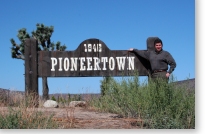 Unlike other movie sets, however, Pioneertown's buildings were not just facades. They were permanent and functional, and served as residences or businesses for the local residents who often appeared as film extras.
Unlike other movie sets, however, Pioneertown's buildings were not just facades. They were permanent and functional, and served as residences or businesses for the local residents who often appeared as film extras.
Rumor has it that Dick Curtis, a Hollywood character actor who spent years at Columbia Pictures portraying villains, loaned $25.00 to an old woman to pay a doctor's bill, and when she could not repay the debt, she gave him the deed to a small piece of land north of Los Angeles. Afterward, Curtis sold the parcel of land and invested the proceeds in some railroad desert property that he had never seen. One day he decided to venture out and visit the property he had acquired.
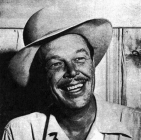 Riding horseback, he finally arrived in an area referred to as Pipes Country, which includes Pipes Wash, Gamma Gulch, Pipes Canyon, Yucca Mesa, Pioneertown, Chaparrosa Wash and Water Canyon. Since mountains surround Pipes Country, the actual route that Curtis took to arrive at the property is a mystery, but the most logical route was through the Yucca Valley and then along the cattle trail north through Water Canyon to present-day Pioneertown (similar route to current Pioneertown Road). After reaching his destination and seeing the land and surrounding mountains, he believed it would be a perfect location for filming Westerns.
Riding horseback, he finally arrived in an area referred to as Pipes Country, which includes Pipes Wash, Gamma Gulch, Pipes Canyon, Yucca Mesa, Pioneertown, Chaparrosa Wash and Water Canyon. Since mountains surround Pipes Country, the actual route that Curtis took to arrive at the property is a mystery, but the most logical route was through the Yucca Valley and then along the cattle trail north through Water Canyon to present-day Pioneertown (similar route to current Pioneertown Road). After reaching his destination and seeing the land and surrounding mountains, he believed it would be a perfect location for filming Westerns.
Soon after returning to Los Angeles, Curtis began discussing the possibility of developing his land into a permanent movie set.
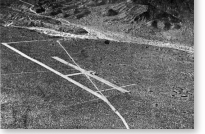 Before long he had convinced 17 others, including Roy Rogers, the Sons of the Pioneers, Russell Hayden, Frank McDonald, Tommy Carr, Terry Frost, and Abbott & Costello, to invest $500 each in this venture. Dick Curtis then became the first president of the newly formed Pioneertown Corporation. Roy Rogers was among some of the original investors who bought several lots, and he had a street named for him. Actress Minna Gombell built a house on the north side of the Sawtooth Mountains in 1947 and also had a road named for her. Gene Autry presumably also invested in the corporation, but he did not purchase any property in Pioneertown.
Before long he had convinced 17 others, including Roy Rogers, the Sons of the Pioneers, Russell Hayden, Frank McDonald, Tommy Carr, Terry Frost, and Abbott & Costello, to invest $500 each in this venture. Dick Curtis then became the first president of the newly formed Pioneertown Corporation. Roy Rogers was among some of the original investors who bought several lots, and he had a street named for him. Actress Minna Gombell built a house on the north side of the Sawtooth Mountains in 1947 and also had a road named for her. Gene Autry presumably also invested in the corporation, but he did not purchase any property in Pioneertown.
On September 1, 1946, Roy Rogers, assisted by the Sons of the Pioneers, Adele Mara, George Tobias, David Bruce and other celebrities, broke ground for the building of Pioneertown. The first building was completed in the spring of 1947 and additional structures soon followed. According to Russell Hayden, this 1880s Western-style town originally was going to be called “Rogersville”, but was instead named “Pioneertown” for the Sons of the Pioneers and for the pioneer spirit of western expansion. Soon there was a boom in land sales and construction through the center of Pioneertown, especially along Mane Street. The Land Office began offering lots of 1.25 to 10 acres in size for as little as $1,250.
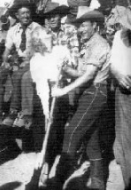 In order to maintain architectural control of the buildings along Mane Street, the Corporation refused to sell lots on this street and only leased them to individuals. Today, architectural control remains in effect mostly by the local residents.
In order to maintain architectural control of the buildings along Mane Street, the Corporation refused to sell lots on this street and only leased them to individuals. Today, architectural control remains in effect mostly by the local residents.
Because of the real estate boom, thoughts of moviemaking in Pioneertown took a back seat as investors began dreaming of a resort area that would surpass Palm Springs. The area’s water shortage was a major obstacle to development, however, and Pioneertown’s viability was questionable. Before long, land sales almost stopped and it looked as though the once promising real estate venture was doomed.
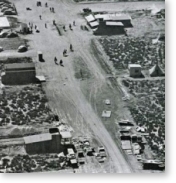 Dick Curtis resigned as president of the Corporation and moved away, and Russell Hayden took over the leadership in September of 1948. Although Curtis was no longer active in the Corporation, he still held more stock and land than anyone else. Even though future prospects appeared dismal, approximately 200 determined men and women bonded together and dedicated themselves to keeping the spirit of Pioneertown alive.
Dick Curtis resigned as president of the Corporation and moved away, and Russell Hayden took over the leadership in September of 1948. Although Curtis was no longer active in the Corporation, he still held more stock and land than anyone else. Even though future prospects appeared dismal, approximately 200 determined men and women bonded together and dedicated themselves to keeping the spirit of Pioneertown alive.
While some residents commuted to work in neighboring towns, others established their own businesses in Pioneertown. Many of them are still in existence, such as the bowling alley Roy Rogers opened in 1949 that has remained in continuous operation ever since. The largest restaurant in Pioneertown, the Golden Stallion, was owned by two Chinese from San Francisco and was constructed out of used railroad ties. Located on the east end of Mane Street, the Golden Stallion served American and Chinese food that was reputed to be "as good as anywhere in the USA." Jack Bailey, actor and game show host of Queen for a Day, later purchased the Golden Stallion. He also owned the Pioneertown Townhouse, which served as the local hotel. Situated just north of the Golden Stallion and also constructed out of used railroad ties,
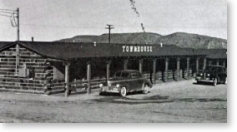 the Townhouse was for a while called the Golden Stallion Lodge. Unfortunately, the Golden Stallion restaurant burned down Easter morning in 1966. The Townhouse still exists, but today it is known as the Pioneertown Motel. To the south of the Golden Stallion was an adobe building that served as the Pony Express Office on one side and a gas station on the other. The adobe building was eventually converted to a restaurant/bar called the Cantina. Today, the Cantina has been enlarged and is known as the Pioneertown Palace or Pappy and Harriet's. Approximately one block west of the Golden Stallion was another restaurant called the Grubstake, which no longer exists. Directly west of the Grubstake restaurant was the Red Dog Saloon, which was owned by partners Al Lipps and Don Kokx. Early aerial photos of the area suggest that present-day paved Pioneertown Road doubled as a landing strip, and legend has it that Lipps and Kokx landed their airplanes on Mane Street and selected the site for the saloon.
the Townhouse was for a while called the Golden Stallion Lodge. Unfortunately, the Golden Stallion restaurant burned down Easter morning in 1966. The Townhouse still exists, but today it is known as the Pioneertown Motel. To the south of the Golden Stallion was an adobe building that served as the Pony Express Office on one side and a gas station on the other. The adobe building was eventually converted to a restaurant/bar called the Cantina. Today, the Cantina has been enlarged and is known as the Pioneertown Palace or Pappy and Harriet's. Approximately one block west of the Golden Stallion was another restaurant called the Grubstake, which no longer exists. Directly west of the Grubstake restaurant was the Red Dog Saloon, which was owned by partners Al Lipps and Don Kokx. Early aerial photos of the area suggest that present-day paved Pioneertown Road doubled as a landing strip, and legend has it that Lipps and Kokx landed their airplanes on Mane Street and selected the site for the saloon.
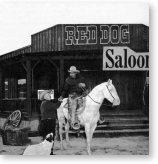 The floor of the Red Dog Saloon was adorned with the face of a woman. Painted by Don Imus, the image is reportedly modeled after longtime resident and Red Dog Saloon entertainer, Dazzling Dallas Morley, who was much loved by locals and dubbed the “Queen of Pioneertown”. Once, in true cowboy fashion, the San Bernardino County Sheriff's Mounted Posse rode their horses right up to the Red Dog’s bar and toasted each other. The Red Dog Saloon burned on Good Friday in 1966, just two days before the similar disaster that hit the Golden Stallion restaurant. The saloon was later rebuilt, but remains empty today. Investigation of these two fires revealed no reason to suspect arson, but the coincidence still puzzles many. The first newspaper in town was the Pioneertown Gazette, printed in the present-day building east of the Red Dog Saloon. Today, this building is a private residence owned by Ms. Linda Himes, but in the filming era it appeared either as a true one-story or as a faux two-story building with an outdoor staircase. Another feature which makes this structure easy to recognize is the Joshua tree growing from its front deck. Across the street from the Gazette is a concrete slab that was specially built for open-air dances, but which today is used by the local church as a basketball court. It has never had a building on it. The Red Dog Saloon, Grubstake, Golden Stallion,
The floor of the Red Dog Saloon was adorned with the face of a woman. Painted by Don Imus, the image is reportedly modeled after longtime resident and Red Dog Saloon entertainer, Dazzling Dallas Morley, who was much loved by locals and dubbed the “Queen of Pioneertown”. Once, in true cowboy fashion, the San Bernardino County Sheriff's Mounted Posse rode their horses right up to the Red Dog’s bar and toasted each other. The Red Dog Saloon burned on Good Friday in 1966, just two days before the similar disaster that hit the Golden Stallion restaurant. The saloon was later rebuilt, but remains empty today. Investigation of these two fires revealed no reason to suspect arson, but the coincidence still puzzles many. The first newspaper in town was the Pioneertown Gazette, printed in the present-day building east of the Red Dog Saloon. Today, this building is a private residence owned by Ms. Linda Himes, but in the filming era it appeared either as a true one-story or as a faux two-story building with an outdoor staircase. Another feature which makes this structure easy to recognize is the Joshua tree growing from its front deck. Across the street from the Gazette is a concrete slab that was specially built for open-air dances, but which today is used by the local church as a basketball court. It has never had a building on it. The Red Dog Saloon, Grubstake, Golden Stallion,
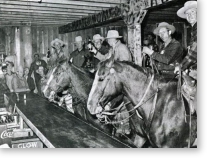 Pioneertown Gazette and Pioneertown Townhouse were the locale’s most often featured buildings on the big screen, as well as on television programs such as The Cisco Kid and The Gene Autry Show, both of which ran for six seasons (1950-1956).
Pioneertown Gazette and Pioneertown Townhouse were the locale’s most often featured buildings on the big screen, as well as on television programs such as The Cisco Kid and The Gene Autry Show, both of which ran for six seasons (1950-1956).
During the 1948 real estate collapse, Hollywood producer Philip N. Krasne was visiting the area and liked the town and its surroundings. Krasne had previously produced three Cisco Kid movies for Monogram, The Cisco Kid Returns (1945), The Cisco Kid in Old New Mexico (1945) and South of the Rio Grande (1945), all starring Duncan Renaldo and Martin Garralaga as Pancho. He believed that Pioneertown, with its high desert appearance of rocky mounds dotted with Joshua trees, would be an excellent location for the next installment of O. Henry's Robin Hood of the West character.
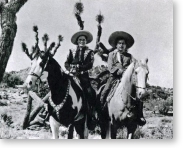 He acquired the movie rights to the area from the Pioneertown Corporation and built the Sound Stage on Mane Street. While much of the filming took place outside, most indoor filming, such as scenes inside a saloon, sheriff's office, printer's office, or ranch house, were done on sets within the Sound Stage. For exterior shots, the Sound Stage appeared as a livery stable or feed store. Soon his production company began shooting Valiant Hombre, which was released through United Artists on December 15, 1948. Four additional Cisco Kid films followed, including The Gay Amigo (1949), The Daring Caballero (1949), Satan's Cradle (1949) and The Girl from San Lorenzo (1950), all of which starred Duncan Renaldo and Leo Carrillo as Pancho.
He acquired the movie rights to the area from the Pioneertown Corporation and built the Sound Stage on Mane Street. While much of the filming took place outside, most indoor filming, such as scenes inside a saloon, sheriff's office, printer's office, or ranch house, were done on sets within the Sound Stage. For exterior shots, the Sound Stage appeared as a livery stable or feed store. Soon his production company began shooting Valiant Hombre, which was released through United Artists on December 15, 1948. Four additional Cisco Kid films followed, including The Gay Amigo (1949), The Daring Caballero (1949), Satan's Cradle (1949) and The Girl from San Lorenzo (1950), all of which starred Duncan Renaldo and Leo Carrillo as Pancho.
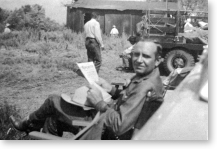 The popularity of these films, aided by the chemistry of Renaldo and Carrillo, led to a TV series by ZIV Television Programs, Inc., which lasted six seasons and 156 episodes. Pioneertown was one of several popular locations at which the series was filmed. Krasne gladly leased sets and location shoots to other producers interested in the area.
The popularity of these films, aided by the chemistry of Renaldo and Carrillo, led to a TV series by ZIV Television Programs, Inc., which lasted six seasons and 156 episodes. Pioneertown was one of several popular locations at which the series was filmed. Krasne gladly leased sets and location shoots to other producers interested in the area.
Since Gene Autry was one of the original investors in the Pioneertown Corporation, his film company, Flying 'A' Productions, utilized Pioneertown for many episodes of The Gene Autry Show, as well as for other Flying ‘A’ series such as The Range Rider, Annie Oakley and Buffalo Bill, Jr. While doing his weekly series, Gene Autry was also actively involved in producing B-Westerns for Columbia Pictures.
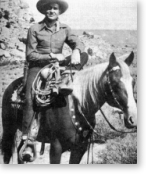 Several of these movies had scenes filmed at Pioneertown, including The Cowboy and the Indians (1949), Riders in the Sky (1949), Indian Territory (1950), Whirlwind (1951), Silver Canyon (1951), Barbed Wire (1952), On Top of Old Smoky (1953), Winning of the West (1953), and Last of the Pony Riders (1953), the latter of which was Gene Autry's last big screen appearance. Promotion for these films was a regular feature at the end of each weekly show when the television audience was reminded: “Be sure to see Gene Autry and Champion in their latest feature-length picture at your local theatre.” Cisco Kid and Gene Autry films made up a large percentage of all films lensed at Pioneertown, and during the 1950s Phillip Krasne and Gene Autry were also responsible for most of the television episodes filmed in Pioneertown.
Several of these movies had scenes filmed at Pioneertown, including The Cowboy and the Indians (1949), Riders in the Sky (1949), Indian Territory (1950), Whirlwind (1951), Silver Canyon (1951), Barbed Wire (1952), On Top of Old Smoky (1953), Winning of the West (1953), and Last of the Pony Riders (1953), the latter of which was Gene Autry's last big screen appearance. Promotion for these films was a regular feature at the end of each weekly show when the television audience was reminded: “Be sure to see Gene Autry and Champion in their latest feature-length picture at your local theatre.” Cisco Kid and Gene Autry films made up a large percentage of all films lensed at Pioneertown, and during the 1950s Phillip Krasne and Gene Autry were also responsible for most of the television episodes filmed in Pioneertown.
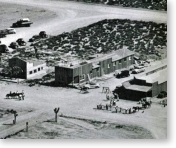 Pioneertown was also the location for Columbia Pictures’ Cody of the Pony Express (1950). Directed by Spencer G. Bennet, the 15-chapter serial starred Dickie Moore and Jock Mahoney, who would later play the Range Rider. The production company built a stockade gate directly in front of the Townhouse to replicate an army fort, and extras portraying cavalry troops marched into and rode out of the “fort”, while army undercover agent Lt. Jim Archer (Mahoney) and other actors exchanged dialogue and played their scenes. As was commonplace during the filming of all movies at Pioneertown, the Townhouse became the sleeping quarters for the serial's cast and crewmembers after a long day’s shoot. Gene Autry apparently always stayed in room #10, and played poker and had cocktails in room #9, which he referred to as Club 9.
Pioneertown was also the location for Columbia Pictures’ Cody of the Pony Express (1950). Directed by Spencer G. Bennet, the 15-chapter serial starred Dickie Moore and Jock Mahoney, who would later play the Range Rider. The production company built a stockade gate directly in front of the Townhouse to replicate an army fort, and extras portraying cavalry troops marched into and rode out of the “fort”, while army undercover agent Lt. Jim Archer (Mahoney) and other actors exchanged dialogue and played their scenes. As was commonplace during the filming of all movies at Pioneertown, the Townhouse became the sleeping quarters for the serial's cast and crewmembers after a long day’s shoot. Gene Autry apparently always stayed in room #10, and played poker and had cocktails in room #9, which he referred to as Club 9.
With the onset of filming, investors began to envision a better future for Pioneertown, and before long, Mane was the site of 34 businesses. Although these businesses changed hands and names through the years, early photographs of Mane show that the actual buildings remained unchanged.
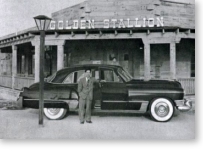 Businesses that operated directly on Mane Street were Golden Stallion, Cecil the Barber, Pioneer Bowl, Pioneer Duds and Saddlery, Pony Express, Grubstake Café, Maggie's Feed Barn, White's Hardware, Klip 'n' Kurl, Marble's Electric Shop, Pioneertown Furniture, Frosted Pantry, Trigger Bill's Shootin' Gallery, Pioneertown Gazette, The Barbeque Corral, Gold Nugget Coffee Shop, Pioneertown Photo Shop, The Townhouse, The Wooden Indian, Likker Barn, Nell's Ice Cream Parlor and Honey Feller's Real Estate Office. The exact location of these businesses is difficult to know, especially since many occupied the same building at different times.
Businesses that operated directly on Mane Street were Golden Stallion, Cecil the Barber, Pioneer Bowl, Pioneer Duds and Saddlery, Pony Express, Grubstake Café, Maggie's Feed Barn, White's Hardware, Klip 'n' Kurl, Marble's Electric Shop, Pioneertown Furniture, Frosted Pantry, Trigger Bill's Shootin' Gallery, Pioneertown Gazette, The Barbeque Corral, Gold Nugget Coffee Shop, Pioneertown Photo Shop, The Townhouse, The Wooden Indian, Likker Barn, Nell's Ice Cream Parlor and Honey Feller's Real Estate Office. The exact location of these businesses is difficult to know, especially since many occupied the same building at different times.
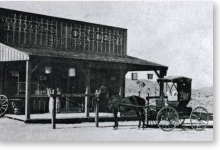 Examination of old photographs and printed material has been helpful in identifying some of these business locations. To begin, the Golden Stallion burned down and was not rebuilt. The location of Cecil the Barber is not known, but could have been the Barber and Beauty Corral, which is the present-day red building opposite the church and west of the Red Dog Saloon, today a private residence. Pioneer Bowl still exists today, but its original wood exterior has been covered with stucco. Across from Pioneer Bowl was Pioneer Duds and Saddlery, which now is also a private residence. Today, Pony Express is part of Pappy and Harriet's Pioneertown Palace. Grubstake Restaurant was torn down and the land remains vacant. Maggie's Feed Barn has also been torn down and its concrete slab exists just northwest of the Post Office between the unoccupied White's Hardware and O.K. Corral. White's Hardware, later called White's Grocery, is the empty building directly across from the present-day Post Office, which used to be Marble's Electric Shop. The vacant building immediately adjacent to the Post Office was the Frosted Pantry, which today has a sign claiming to be the Sheriff's Office. The Pioneertown Bulletin Board is attached to the building’s west side.
Examination of old photographs and printed material has been helpful in identifying some of these business locations. To begin, the Golden Stallion burned down and was not rebuilt. The location of Cecil the Barber is not known, but could have been the Barber and Beauty Corral, which is the present-day red building opposite the church and west of the Red Dog Saloon, today a private residence. Pioneer Bowl still exists today, but its original wood exterior has been covered with stucco. Across from Pioneer Bowl was Pioneer Duds and Saddlery, which now is also a private residence. Today, Pony Express is part of Pappy and Harriet's Pioneertown Palace. Grubstake Restaurant was torn down and the land remains vacant. Maggie's Feed Barn has also been torn down and its concrete slab exists just northwest of the Post Office between the unoccupied White's Hardware and O.K. Corral. White's Hardware, later called White's Grocery, is the empty building directly across from the present-day Post Office, which used to be Marble's Electric Shop. The vacant building immediately adjacent to the Post Office was the Frosted Pantry, which today has a sign claiming to be the Sheriff's Office. The Pioneertown Bulletin Board is attached to the building’s west side.
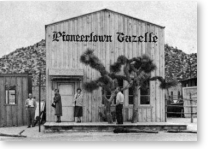 The present-day Pioneertown Church used to be the Pioneertown Furniture building. Trigger Bill's Shootin' Gallery, located between Pioneer Bowl and Sound Stage, stands closed. Pioneertown Gazette is a private residence directly across the street from the open concrete slab built especially for open-air dances. The Barbeque Corral, formerly located on the west side of the Red Dog Saloon, is currently a private residence and has been moved to another part of Pioneertown. The Likker Barn remains unchanged from when it was originally the Gold Nugget Coffee Shop. Located on the east side of Pioneer Bowl, the Likker Barn has also served as a visitor's center and Honey Feller's Real Estate Office.
The present-day Pioneertown Church used to be the Pioneertown Furniture building. Trigger Bill's Shootin' Gallery, located between Pioneer Bowl and Sound Stage, stands closed. Pioneertown Gazette is a private residence directly across the street from the open concrete slab built especially for open-air dances. The Barbeque Corral, formerly located on the west side of the Red Dog Saloon, is currently a private residence and has been moved to another part of Pioneertown. The Likker Barn remains unchanged from when it was originally the Gold Nugget Coffee Shop. Located on the east side of Pioneer Bowl, the Likker Barn has also served as a visitor's center and Honey Feller's Real Estate Office.
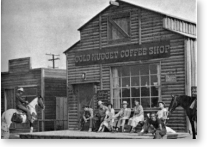 The Wooden Indian is believed to have been located in one of the two buildings directly across from the Likker Barn. The small “Marshall’s Office” adjacent to the Likker Barn was formerly Carol Burgess' Gift Shop. Nell's Ice Cream Parlor has been removed and a private residence has been constructed on its site. The Land Office, directly across the street from the Sound Stage, was the first building constructed in Pioneertown. The building immediately adjacent to the Land Office, on the east side, is a private residence, which apparently has served as a second location for the Pioneertown Post Office as well as for Duds and Saddlery. Across from the bowling alley are the present-day Wagon Wheel Saloon, Pioneertown Bank, Bath House, Livery Stable, Sheriff's Office and Jail, all of which are mere facades. These facades become the backdrop for local western shows
The Wooden Indian is believed to have been located in one of the two buildings directly across from the Likker Barn. The small “Marshall’s Office” adjacent to the Likker Barn was formerly Carol Burgess' Gift Shop. Nell's Ice Cream Parlor has been removed and a private residence has been constructed on its site. The Land Office, directly across the street from the Sound Stage, was the first building constructed in Pioneertown. The building immediately adjacent to the Land Office, on the east side, is a private residence, which apparently has served as a second location for the Pioneertown Post Office as well as for Duds and Saddlery. Across from the bowling alley are the present-day Wagon Wheel Saloon, Pioneertown Bank, Bath House, Livery Stable, Sheriff's Office and Jail, all of which are mere facades. These facades become the backdrop for local western shows
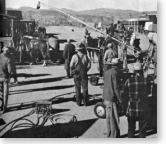 performed each weekend during spring, summer and autumn. There are two new buildings across the street from the Likker Barn, and one of them is marked General Mercantile.
performed each weekend during spring, summer and autumn. There are two new buildings across the street from the Likker Barn, and one of them is marked General Mercantile.
The Pioneertown Post Office is the terminus for the annual Pony Express Ride sponsored by the Yucca Valley Chamber of Commerce and the Morongo Basin Horseman's Association. After the mail is hand-cancelled at the Post Office, the mail carrier is held up by the infamous Pioneertown Posse. The Posse consists of two gangs, the Black and White Rock Gangs, who take turns claiming the right to rob the mail.
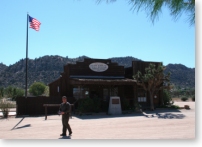 Predictably, an argument ensues and the gangs kill each other off, which thus allows the mail to continue on to its official destination. The Pioneertown Post Office has only had slight structural changes over the years, and is alleged to be the most photographed post office in the United States.
Predictably, an argument ensues and the gangs kill each other off, which thus allows the mail to continue on to its official destination. The Pioneertown Post Office has only had slight structural changes over the years, and is alleged to be the most photographed post office in the United States.
After a few years, both Gene Autry and Phil Krasne decided to pull up stakes and move on to other projects and locations. The Pioneertown Corporation was already under the leadership of Russell Hayden, who had physically helped blast a road between the Pioneertown Plateau and Water Canyon. Reportedly, Hayden was instrumental in hauling dynamite in his own vehicle and carrying out much of the physical labor necessary for the blasting of boulders. San Bernardino County offered no assistance in establishing the road,
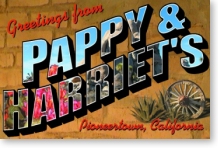 but eventually took over its management after Hayden and others had worked hard to develop it.
but eventually took over its management after Hayden and others had worked hard to develop it.
In 1955, Russell Hayden was successful in getting sponsors for the Judge Roy Bean TV series and built a set on his property for the purpose of filming it. The 35-acre Hayden Ranch, a reproduction of Langtry, Texas, is located slightly southeast of Pappy & Harriet's Pioneertown Palace where a red railroad car can still be seen. The Judge Roy Bean series ran during the 1956-57 season for a total of 39 episodes. Sandra Hayden, Russell Hayden's daughter by his previous marriage to actress Jan Clayton, also appeared on a couple of Judge Roy Bean episodes. Even though she continued to live with her mother, Sandra maintained a close relationship with her dad and step-mother, actress Lillian "Mousie" Porter.
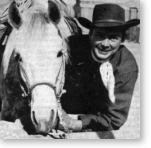 Tragically, one evening in September 1956 Sandra was killed in a car accident while driving on Coldwater Canyon Road on her way from Jan Clayton's house to Russell and Mousie's. The devastated Haydens never fully recovered from their grief over losing Sandy. They left Pioneertown for a while and moved to Scottsdale, Arizona. During the two years that followed (1957-59), Hayden produced 26 Men, which highlighted true stories of the Arizona Rangers around 1900. Although most of the 78 episodes were actually filmed in Arizona, several were also lensed in Pioneertown. Russell and Mousie Hayden eventually returned to Pioneertown and settled for good at the Hayden Ranch. They established the Sandra Hayden Memorial Fund, and for years hosted 4th of July barbecues at their ranch for the purpose of raising funds for community residents who had suffered severe illnesses or accidents.
Tragically, one evening in September 1956 Sandra was killed in a car accident while driving on Coldwater Canyon Road on her way from Jan Clayton's house to Russell and Mousie's. The devastated Haydens never fully recovered from their grief over losing Sandy. They left Pioneertown for a while and moved to Scottsdale, Arizona. During the two years that followed (1957-59), Hayden produced 26 Men, which highlighted true stories of the Arizona Rangers around 1900. Although most of the 78 episodes were actually filmed in Arizona, several were also lensed in Pioneertown. Russell and Mousie Hayden eventually returned to Pioneertown and settled for good at the Hayden Ranch. They established the Sandra Hayden Memorial Fund, and for years hosted 4th of July barbecues at their ranch for the purpose of raising funds for community residents who had suffered severe illnesses or accidents.
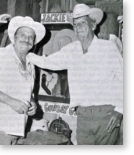 Notables who attended the annual barbecue included Jackie Coogan, Sunset Carson, Jimmy Wakely, Mrs. Hoot Gibson, Bob Nolan and Jan Clayton. Board members were locals who planned, directed and carried out the activities of the Fund. In 1977, a young woman who lost one of her legs to cancer became the Fund’s first recipient. Russell Hayden passed away June 8, 1981, one day before his 70th birthday, and Mousie and the Board continued the Fund for several more years.
Notables who attended the annual barbecue included Jackie Coogan, Sunset Carson, Jimmy Wakely, Mrs. Hoot Gibson, Bob Nolan and Jan Clayton. Board members were locals who planned, directed and carried out the activities of the Fund. In 1977, a young woman who lost one of her legs to cancer became the Fund’s first recipient. Russell Hayden passed away June 8, 1981, one day before his 70th birthday, and Mousie and the Board continued the Fund for several more years.
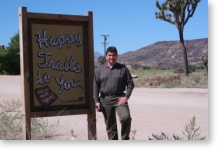 Mousie Hayden reportedly received her nickname from 20th Century-Fox chief Darryl F. Zanuck, who said she was “cute as a little mouse.” She outlived Russell Hayden by nearly sixteen years and died on February 1, 1997. Several years after her death, retired Flying Tiger Airlines' pilot John Ristaino and his wife Carolyn purchased the Hayden property. They envisioned restoring the ranch to its original condition, but unfortunately recent fires have destroyed most of the buildings.
Mousie Hayden reportedly received her nickname from 20th Century-Fox chief Darryl F. Zanuck, who said she was “cute as a little mouse.” She outlived Russell Hayden by nearly sixteen years and died on February 1, 1997. Several years after her death, retired Flying Tiger Airlines' pilot John Ristaino and his wife Carolyn purchased the Hayden property. They envisioned restoring the ranch to its original condition, but unfortunately recent fires have destroyed most of the buildings.
Pioneertown’s estimated value in 1950 was $1.5 million, and it had remained a relatively popular film location site throughout the late 1940s and early 1950s. Nevertheless, because of lackluster land sales Pioneertown had to go on the auction block. In November 1950, two automobile dealers from Los Angeles were the successful bidders at an auction held at the San Bernardino Court House. Fletcher Jones and Bill Murphy never revealed any specific objective for the property they bought, nor did they develop it during the nearly fifteen years that they held it.
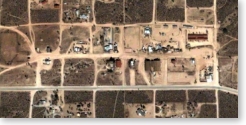 In the mid-1960s, Benton Lefton, a former Cleveland developer and head of the California Golden Empire, acquired all of the old Pioneertown Corporation and planned a mammoth development. Lefton hired experts to see how the area could be developed into a master planned resort. He envisioned a $400 million development with 500 two-acre lots, 500 other larger sites ranging in size from 2 to 22 acres, 1,000 acres of condominiums and townhouses, 1,000 acres of shopping centers and other commercial enterprises, 1,000 acres of industrial projects, and 1,000 acres for community use such as parks, churches and recreational areas. Larger parcels suitable for ranches, summer camps, and other similar uses would total 3,000 acres. The Golden Empire was to be developed in sections and phases covering the entire 32,000 acres of the original Pioneertown Company.
In the mid-1960s, Benton Lefton, a former Cleveland developer and head of the California Golden Empire, acquired all of the old Pioneertown Corporation and planned a mammoth development. Lefton hired experts to see how the area could be developed into a master planned resort. He envisioned a $400 million development with 500 two-acre lots, 500 other larger sites ranging in size from 2 to 22 acres, 1,000 acres of condominiums and townhouses, 1,000 acres of shopping centers and other commercial enterprises, 1,000 acres of industrial projects, and 1,000 acres for community use such as parks, churches and recreational areas. Larger parcels suitable for ranches, summer camps, and other similar uses would total 3,000 acres. The Golden Empire was to be developed in sections and phases covering the entire 32,000 acres of the original Pioneertown Company.
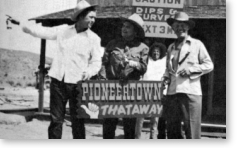 Corporate water witching tapped one dry well after another, and the grandiose plans of Golden Empire's venture ultimately fell through. Today, it is still unclear how present-day Pioneertown was subdivided. The one-square-mile area that encompasses Pioneertown proper was divided into residential parcels ranging in size from 1.25 to 40 acres, and the division of lots on Mane Street’s movie set area had no particular pattern. These inconsistencies have resulted in more than a few heated boundary disputes.
Corporate water witching tapped one dry well after another, and the grandiose plans of Golden Empire's venture ultimately fell through. Today, it is still unclear how present-day Pioneertown was subdivided. The one-square-mile area that encompasses Pioneertown proper was divided into residential parcels ranging in size from 1.25 to 40 acres, and the division of lots on Mane Street’s movie set area had no particular pattern. These inconsistencies have resulted in more than a few heated boundary disputes.
Located midway between Palm Springs and Joshua Tree, visitors may reach Pioneertown from Los Angeles by driving east on Interstate 10 for approximately two hours and then turning north on Highway 62 to Yucca Valley. Turn left (north) on Pioneertown Road and proceed approximately four miles into Pioneertown.